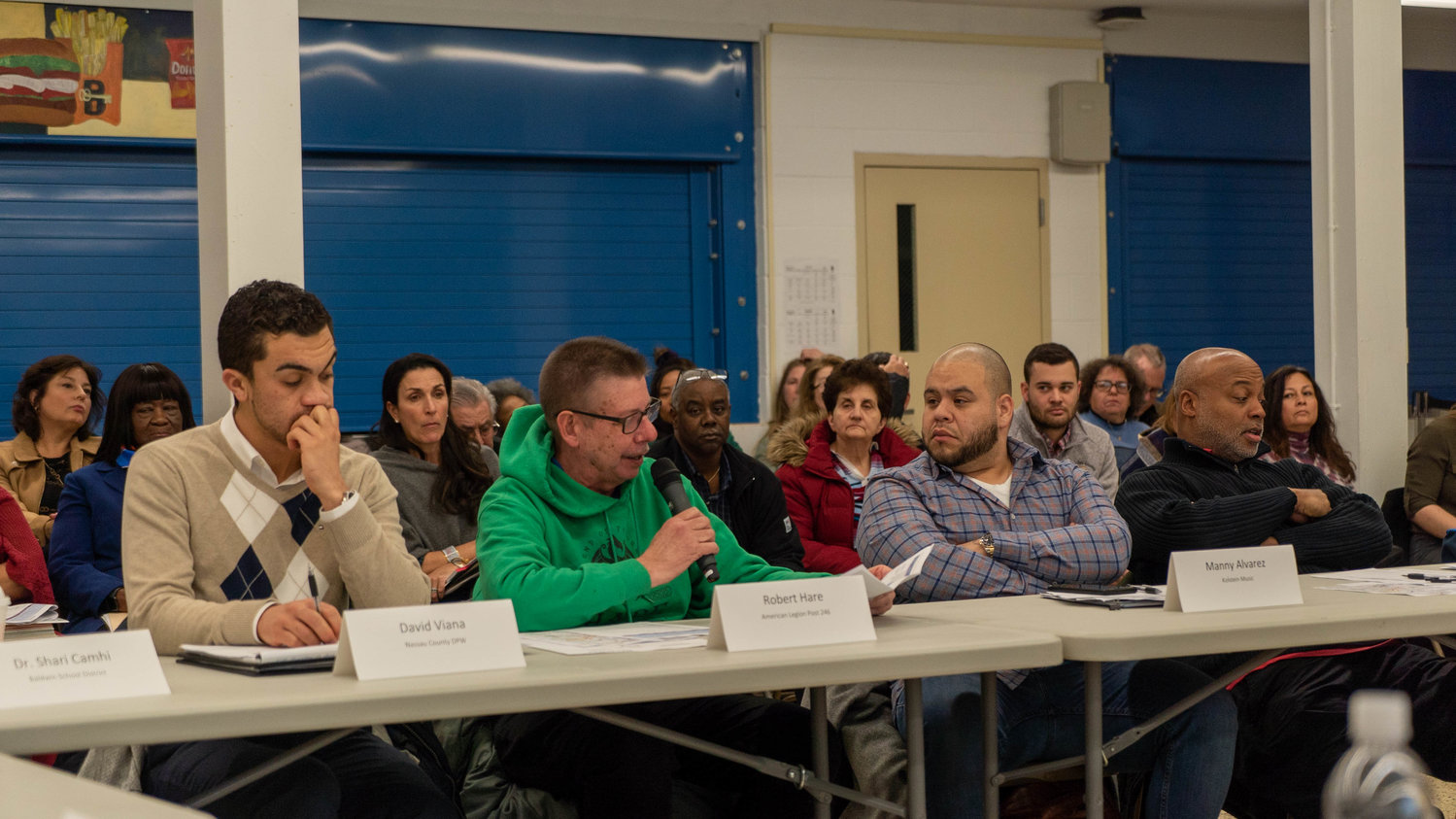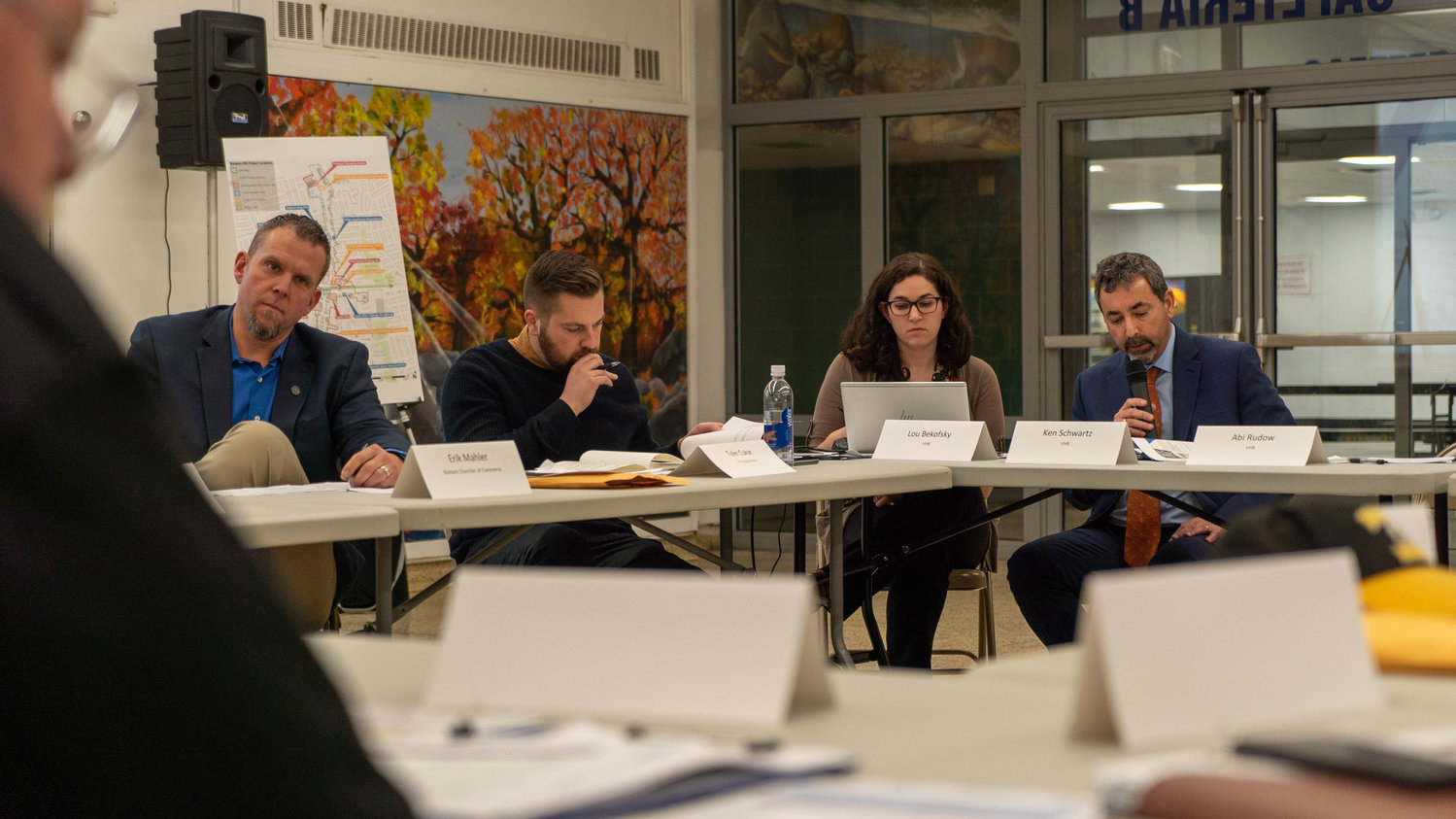Wednesday, April 24, 2024
 49.0°,
Fair
49.0°,
Fair
Residents seek large-scale development at DRI meeting
List of Baldwin revitalization projects narrowed

—Baldwin Dog Park
Total project cost: $40,000
DRI funds request: $40,000
—Baldwin Downtown Public Art Project
Total project cost: $192,500
DRI funds request: $192,500
—Implementation of Green Infrastructure/Storm Resiliency
Total project cost: $1.5 million
DRI funds request: $1.5 million
—Baldwin Historical Society and Museum Site and Building Renovation
Total project cost: $2,050,000
DRI funds request: $2,050,000
—Kellogg House Community Space Improvements
Total project cost: $745,000
DRI funds request: $345,000
—Baldwin Library Interior Renovations
Total project cost: $4,124,000
DRI funds request: $3,471,000
—Coach Diner Signage and Lighting
Total project cost: $18,792
DRI funds request: $10,000
—800 Merrick Road Redevelopment
Total project cost: $1 million
DRI funds request: $250,000
—Baldwin Business Center
Total project cost: $770,000
DRI funds request: $320,000
—Revolving Loan Fund or Grant Program
Total project cost: TBD
DRI funds request: $600,000
—Baldwin Chamber of Commerce Facade Renovation and Digital Sign
Total project cost: $50,000
DRI funds request: $50,000
—Transit-oriented development
Total project cost: TBD
DRI funds request: TBD
—775 Brooklyn Ave. Transit-Oriented Development
Total project cost: TBD
DRI funds request: TBD
—Placemaking and Streetscape Improvements
Total project cost: TBD
DRI funds request: $20,000 to $250,000
—Baldwin Public Library Plaza Enhancement and Reactivation
Total project cost: $870,000
DRI funds request: $870,000
—Malkin Appliances Site Renovations
Total project cost: $1,175,280
DRI funds request: $240,000
—Baldwin High School Gateway Improvements
Total project cost: TBD
DRI funds request: TBD
—Enhance Commuter Amenities
Total project cost: TBD
DRI funds request: TBD
—Downtown Branding or Marketing Program
Total project cost: $15,000
DRI funds request: $15,000
—Merrick Road Traffic and Pedestrian Safety Improvements
Total project cost: TBD
DRI funds request: TBD
—Baldwin LIRR Station Plaza
Total project cost: TBD
DRI funds request: TBD
—Recreation Center
Total project cost: TBD
DRI funds request: TBD
—Food Business Incubation and Grocery
Total project cost: TBD
DRI funds request: TBD
—Sunrise Trail and Sunrise Highway Pedestrian Improvements
Total project cost: TBD
DRI funds request: TBD
—Pedestrian Walkway Improvements
Total project cost: TBD
DRI funds request: TBD
—Arts and Cultural Center
Total project cost: $250,000
DRI funds request: $250,000
Residents, consultants, and state and Town of Hempstead officials gathered for the latest meeting of the Baldwin Downtown Revitalization Initiative on Jan. 29 at Baldwin High School, where they narrowed the potential list of projects to overhaul the long-struggling downtown.
“This is sort of like going to a restaurant and there are 29 items on the menu,” said Ken Schwartz, senior vice president of VHB Engineering, a consulting team helping to draw up plans for the downtown. He and members of the Local Planning Committee, comprising community leaders and business owners, discussed 29 potential projects, including a dog park, storm resiliency infrastructure and library renovations.
Paving the way for development, the Hempstead Town Board voted on Jan. 21 to adopt the Baldwin zoning overlay district, which creates a temporary zoning code meant to attract developers and revitalize the downtown, which has had empty storefronts and vacant buildings for nearly 20 years.
Lou Bekofsky, of VHB, said it “really sets the stage for what could be done in downtown Baldwin. Since that time — since actually the call for projects came in — we’ve been looking at all the projects, reviewing them, started fleshing them out, identifying sponsors and potential cost estimates associated with them.”
Baldwin re-ceived a $10 million grant from the state last year to redevelop its downtown, and many residents said they hoped the funds would help return the area to a bustling business district, as it once was.
Local Planning Committee members entertained the idea of a Baldwin dog park, which would cost about $40,000 in Downtown Revitalization Initiative funds and would be located south of Seaman Avenue, behind the Baldwin Historical Society office.
“It should be noted that this is on land that is not developable because of environmental constraints that are on the property,” Schwartz said. A handful of residents praised the idea.
Some projects, like the Baldwin Downtown Public Art Project and the Downtown Branding or Marketing Program, strive to create a cohesive, unified brand for the hamlet that would provide “a sense of community.”
Other projects, including the Implementation of Green Infrastructure/Storm Resiliency, aim to reduce the risk of flooding in low-lying areas during future storms.
The list of projects discussed at the meeting, Bekofsky said, were “those projects that have the biggest bang for their buck and the most community support.” Some residents, however, asked why there were not more business, housing or large-scale development projects on the list.
“At what point are we going to start seeing larger-scale business developments?” Baldwin Chamber of Commerce President Erik Mahler asked. “Some of them are great ideas . . . but the whole point of this is for business, downtown redevelopment. What is this doing for building businesses and large-scale developments in the Baldwin community?”
A few people clapped.
“Now that the zoning is there,” Bekofsky said, “we can go to the developers and say, ‘Where are you looking?’”
Developers were waiting for the town to adopt the overlay district, he said, and now that it has been finalized, developers have been searching for specific sites on which to build. “There has to be some certainty,” Bekofsky said, “and the certainty has to be that there is a potential site to do something transformative.”
Baldwin American Legion Commander Bob Hare and Dave Kappel, of the Regional Economic Development Council, who co-chairs the Local Planning Committee with Hempstead Town Supervisor Donald Clavin, agreed with Mahler.
“The one thing, based on all of our discussions, is that it’s going to be transit-oriented and there’s going to be housing,” Hare told the consultants. “. . . And the one huge thing that’s missing in here — I’m just going to state it for the record — is any kind of significant housing development at all. I mean, that’s going to be a major downside.”
LPC members and consultants also proposed renovating the ground floor of the Baldwin Public Library, expanding the upper floor and creating community meeting spaces. The total cost of the project was estimated at $4.1 million, about $3.4 million of which would be Downtown Revitalization Initiative funds.
“In reviewing this, it’s the most expensive thing on the menu,” Schwartz said. “It would essentially use 35 percent of the DRI total funding for this one project. That’s something to be considered by the LPC from an investment standpoint.”
Additionally, a new building fronting Grand Avenue would be constructed as part of the Baldwin Historical Society and Museum Site and Building Renovation project. The existing building would also be renovated, and the total project cost would be about $2 million, with all funds coming from the DRI.
“I’m so confused, angry, frustrated,” Baldwin resident Linda Degen said toward the end of the meeting. The Baldwin Historical Society and library projects are “$6.5 million of this money that’s supposed to be to develop to make the community look better, to make the appearance of our community better, to make the transit-oriented development better,” Degen said.
“To Erik [Mahler]’s point, he’s 100 percent right about this being about bringing businesses into this community, developing and making it look nicer,” Degen said. The historical society project “is $2.5 million of this opportunity that we’re never going to get again. . . . That’s a tremendous amount of money that would need to be put down, in my opinion.”
“There are a lot of projects here that could be funded with other public monies,” Library Director Elizabeth Olesh responded. “So I think that they should all be evaluated in the same way, and that we shouldn’t just pick out one of them — we should look at all of them from that perspective.”
Karen Montalbano, of the Baldwin Historical Society, recommended that LPC members and consultants consider projects that could be completed with existing programs. “The money that’s being asked for may be available someplace else,” she said.
Freeport resident Jill Kaplan recommended adding a supermarket to the site where Pathmark used to sit along Grand Avenue. “I don’t know if this is part of it,” she said, “but if it could be, we need a supermarket.”
The next LPC meeting is scheduled for Feb. 12. The final DRI Investment Plan is due to the state by April 24.
HELP SUPPORT LOCAL JOURNALISM
The worldwide pandemic has threatened many of the businesses you rely on every day, but don’t let it take away your source for local news. Now more than ever, we need your help to ensure nothing but the best in hyperlocal community journalism comes straight to you. Consider supporting the Herald with a small donation. It can be a one-time, or a monthly contribution, to help ensure we’re here through this crisis. To donate or for more information, click here.
Sponsored content
Other items that may interest you









